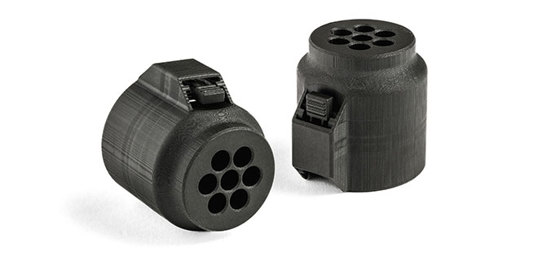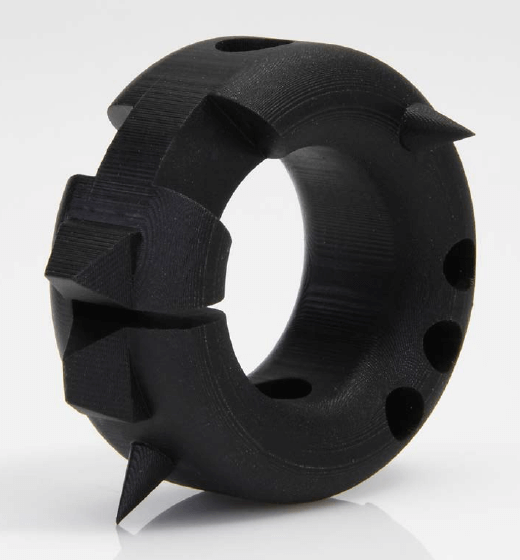Talk with Our Team
Hello! We just need a few bits of information then a manufacturing expert will reach out to you directly to see we how can partner on a future production project.
Thank you! We've received your request and a member of our team will reach out shortly.

Carbon DLS
Want faster, cost-efficient production? Try Carbon DLS for 3D-printed plastic parts with injection moulding-like strength—in days.
shield_locked All Uploads are Secure and Confidential
Certifications ISO 9001:2015 | ISO 14001:2015 | ISO 13485 (Protolabs Network)
Why Choose Carbon DLS for 3D Printing
Carbon DLS (digital light synthesis) Is an industrial 3D printing process that produces functional, end-use parts with mechanically isotropic properties and smooth surface finishes. It offers a range of rigid and flexible polyurethane materials designed for high-impact resistance and durability to meet your needs.
Key Advantages and Uses:
- Ideal for complex designs that are difficult to mould
- Provides isotropic mechanical properties and smooth surface finishes
- Produces parts in materials similar to ABS or polycarbonate
- Suitable for durable, end-use components

EPX 82 - By Carbon
expand_less expand_moreCarbon EPX 82 is a high-strength epoxy-based engineering material with excellent long-term durability and mechanical properties comparable to lightly glass-filled thermoplastics (e.g. 20% GF-PBT, 15% GF-Nylon).
Primary Benefits
- High -Strength
- Long-Term Durability
- Functional Toughness
EPX 86FR - By Carbon
expand_less expand_moreCarbon EPX 86FR is a flame-retardant resin that offers functional toughness, high strength, and long-term stability. It works well in a variety of applications that require UL 94 V-0 or FAR 25.853(a) ratings.
Primary Benefits
- Flame retardant (UL94 V-0 at 2 mm thick)
- Chemical resistance
FPU 50 - By Carbon
expand_less expand_moreCarbon FPU 50 exhibits the highest elongation of any of the 3D printing thermoset resins at 200% making it the most flexible option. Available in black, it falls under the PP-like category of 3D printing resins.
Primary Benefits
- Highest elongation properties
- Fatigue resistance
RPU 70 Rigid Polyurethane
expand_less expand_moreRPU 70 Rigid Polyurethane is manufactured through Carbon’s DLS (digital light synthesis) process. It is a tough all-purpose engineering grade material that comes in black and can be categorised as an ABS-like materials.
Primary Benefits
- Tough material
- UL 94 HB flame resistance classification
Compare Material Properties for Carbon DLS
| Material | Colour | Tensile Strength | Tensile Modulus | Elongation |
|---|---|---|---|---|
| EPX 82 - By Carbon | Black | 84 MPa | 2,800 MPa | 8% |
| EPX 86FR - By Carbon | Black | 90 MPa | 3,300 MPa | 10% |
| RPU 70 - By Carbon | Black | 41.4 MPa | 1,690 MPa | 100% |
| Carbon FPU 50 | Black | 27.6 MPa | 690 MPa | 200% |
These figures are approximate and dependent on a number of factors, including but not limited to, machine and process parameters. The information provided is therefore not binding and not deemed to be certified. When performance is critical, also consider independent lab testing of additive materials or final parts.

Unfinished
With unfinished, you get varying aesthetics based on build orientation. Dots or standing nibs remain evident on the bottom of the part from the support structure remnants.

Natural Finish
With natural finishing, you get varying aesthetics based on build orientation. Standing nibs are sanded flat.
How Does Carbon DLS Work?
Carbon DLS uses CLIP (continuous liquid interface production) technology to produce parts through a photochemical process that balances light and oxygen. It works by projecting light through an oxygen-permeable window into a reservoir of UV-curable resin. As a sequence of UV images are projected, the part solidifies, and the build platform rises.
At the core of the CLIP process is a thin, liquid interface of uncured resin between the window and the printing part. Light passes through that area, curing the resin above it to form a solid part. Resin flows beneath the curing part as the print progresses, maintaining the continuous liquid interface that powers CLIP. Following the build, the 3D-printed part is baked in a forced-circulation oven where heat sets off a secondary chemical reaction that causes the materials to adapt and strengthen.









